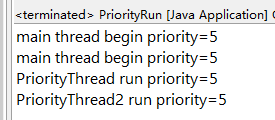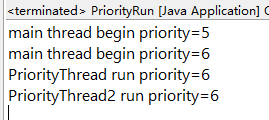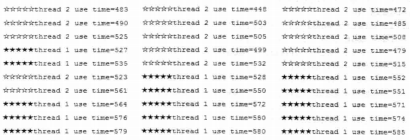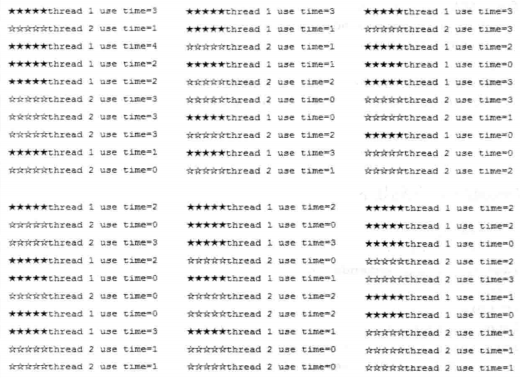在操作系统中,线程可以划分优先级,优先级较高的线程得到的CPU资源较多,也就是CPU优先执行优先级较高的线程对象中的任务。
设置优先级
设置线程优先级有助于帮“线程规划器”确定在下一次选择哪一个线程来优化执行。
设置线程的优先级使用setPriority()方法,此方法在JDK的源代码如下:
在Java中,线程的优先级分为1~10这10个等级,如果小于1或大于10,则JDK抛出异常throw new IllegalArgumentException()。
JDK中使用3个常量来预置定义优先级的值,代码如下:
线程优先级的继承特性
在Java中,线程的优先级具有继承性,比如A线程启动B线程,则B线程的优先级与A是一样的。
代码清单1 线程优先级的继承
程序运行后效果如图1所示。

图1 优先级被继承
将代码//Thread.currentThread().setPriority(6);前的注释符号去掉,再次运行,显示如图2所示。
程序运行后效果如图1所示。

图2 优先级被更改在继续继承
优先级具有规划性
虽然使用setPriority()方法可以设置线程的优先级,但还没有看到设置优先级所带来的效果。
代码清单2 优先级规划性
高优先级的线程相对总数先执行完,如图3所示。

图3 运行结果
从图3中可以发现,高优先级的线程总是大部分先执行完,但不代表高优先级的线程全部执行完。另外,不要以为PanningThread线程先被main线程所调用就会先执行完,出现这些的结果全是因为PanningThread线程的优先级是最高值为10所造成的。当线程优先级的等级差距很大时,谁先执行完和代码的调用顺序无关。为了验证这个结论,继续实验,改变PanningRun方法,代码如下。
代码清单3 修改PanningRun()中优先级
大部分的thread2先执行完,也就验证了线程的优先级与代码执行的顺序无关,出现这样的结果是因为PanningThread2的优先级是最高的,说明线程额优先级具有一定的规划性,也就是CPU尽量将执行资源让给优先级比较高的线程。

图4 大部分thread2先执行完
优先级具有随机性
前面案例介绍了线程的优先级较高则优先执行完run()方法中的任务。但这个结果不能说得太肯定,因为线程的优先级还具有“随机性”,也就是优先级较高的线程不一定每一次都先执行完。
代码清单4 随机性
执行上面代码6次,结果如下。

图5 运行6次后的结果
不要把线程的优先级与运行结果的顺序作为衡量的标准,优先级较高的线程并不一定每一次都先执行完run()方法中的任务,也就是说,线程优先级与打印的顺序无关,不要将这两者的关系相关联,它们的关系具有不确定性和随机性。
看谁运行得快
相同情况下,不同优先级下,比较运行快慢。
代码清单5 比较运行速度

图6 优先级高运行得快

